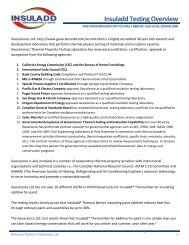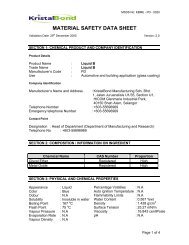I_Test - BTU - SandS International
I_Test - BTU - SandS International
I_Test - BTU - SandS International
You also want an ePaper? Increase the reach of your titles
YUMPU automatically turns print PDFs into web optimized ePapers that Google loves.
Tech Traders Inc.<br />
150 Venetian Way, Suite 103<br />
Merritt Island, FL 32953<br />
Phone (321) 453-5060<br />
Fax (321) 453-9530<br />
www.insuladd.com<br />
WHY INSULADD ??<br />
The average 2,500 sq ft home located in a moderate winter zone in the U.S.<br />
requires 5 million <strong>BTU</strong>s per month to heat and in excess of 7 million <strong>BTU</strong>s<br />
to heat in a severe winter zone. To be able to economically and easily reduce<br />
this consumption by 20% would mean a reduction of one million to almost one<br />
and one half million <strong>BTU</strong>s per home at an average potential annual household<br />
savings in excess of $650.00 In the South you see identical results with airconditioning<br />
load reduction and corresponding drop in electrical consumption.<br />
INSULADD is the only paint additive proven over and over again to make<br />
ordinary house paint refl ect heat and perform as a radiant barrier.<br />
This graph shows the<br />
dramatic reduction in<br />
heat passing through<br />
paint after insuladd<br />
has been added. It also<br />
shows the performance<br />
of some Insuladd paint<br />
products.<br />
Readings are measured<br />
in <strong>BTU</strong>/HR*FT2.<br />
These <strong>BTU</strong> readings<br />
were taken at various<br />
times during the day<br />
with the highest reading<br />
of 168 <strong>BTU</strong> taken<br />
at 2:00 PM June 29 in<br />
Central Florida.<br />
WHY INSULADD YOU MIGHT ASK??<br />
Conventional insulation materials like fi berglass, cellulose, rock wool and<br />
Styrofoam, no matter how thick, have almost no ability to block radiant heat<br />
energy which can account for as much as 93 percent of summer heat gain<br />
and up to 75 percent winter heat loss in conventional structures.<br />
These products are only designed to slow down (resist) conduction heat energy.<br />
Insulation once saturated with heat will simply allow remaining heat<br />
to pass through. Ever notice in the summer, its 10 PM or so, and you touch<br />
one of the walls in your home that butts up to the outside, the sun has been<br />
down for hours, but the wall is still Hot! That’s because the wall has been<br />
absorbing heat all day and is passing it through the wall to the inside of your<br />
home. Remember ... R-value means “resistance,” if a product resists, it does<br />
not stop radiant heat transfer. R-value material only deals with conductive<br />
heat transfer.<br />
INSULADD mixed into ordinary paint has the ability to<br />
block a substantial amount of that radiant energy that accounts<br />
for the 75% winter heat loss and 93% summer heat<br />
gain in conventional structures.<br />
INSULADD is a trademarked and patented product of Tech<br />
Traders Inc., Merritt Island FL (321) 453-5060.
Tech Traders Inc.<br />
150 Venetian Way, Suite 103<br />
Merritt Island, FL 32953<br />
Phone (321) 453-5060<br />
Fax (321) 453-9530<br />
www.insuladd.com<br />
UNDERSTANDING <strong>BTU</strong>S<br />
A <strong>BTU</strong>, short for British Thermal Unit, is a basic measure of thermal (heat) energy. One <strong>BTU</strong> is the amount of energy<br />
needed to heat one pound of water one degree Fahrenheit, measured at its heaviest point. In other words, if you placed<br />
16 ounces of water at 59°F into a stovetop pan and turned on the gas burner, it would take one <strong>BTU</strong> to raise the temperature<br />
of the water to 60°F. As more <strong>BTU</strong>s continue to flow from the gas flame, the water will eventually reach the<br />
boiling point of 212°F.<br />
A <strong>BTU</strong> is also the equivalent of 252 heat calories, not to be confused with the kilo-calories of food, and of approximately<br />
a third of a watt-hour. When speaking of cooling power, the <strong>BTU</strong> also works in reverse. The air-cooling power<br />
of an air conditioning system refers to the amount of thermal energy removed from an area. Hence a 65,000 <strong>BTU</strong> heater<br />
and a 65,000 <strong>BTU</strong> air conditioner are of roughly the same capacity and size. The higher the <strong>BTU</strong> output, the more<br />
powerful the heating or cooling system.<br />
Strangely enough, the British Thermal Unit is rarely used in Great Britain anymore, where it is considered a non-metric<br />
measurement. Even in countries which use the <strong>BTU</strong> as a standard measurement, there is some disagreement over the<br />
formula used to derive it. The thermal energy needed to raise water one degree Fahrenheit can depend on the original<br />
temperature and the method used for heating. So, it is possible to get several different definitions of a <strong>BTU</strong> from different<br />
sources. This rarely has a tangible effect on consumer product information, however.<br />
Most heating and cooling systems produce thousands of <strong>BTU</strong>s, almost rendering the measurement of one <strong>BTU</strong> pointless.<br />
One is more likely to encounter smaller <strong>BTU</strong> figures during scientific experiments where the slightest change in<br />
thermal energy may need to be calculated in terms of calories. When dealing<br />
with central air conditioning units and commercial pizza ovens, however,<br />
the <strong>BTU</strong> numbers can easily reach the hundreds of thousands. A unit<br />
of measure called the MM<strong>BTU</strong> is the equivalent of a million <strong>BTU</strong>s, however,<br />
few man-made objects can generate this level of thermal energy.<br />
When shopping for heating or cooling systems, keep in mind that even<br />
the smallest window-mounted air conditioner or space heater can produce<br />
thousands of <strong>BTU</strong>s. The <strong>BTU</strong> numbers should primarily be used<br />
as a comparison between systems. Larger and more expensive systems<br />
should provide significantly higher <strong>BTU</strong>s than smaller ones. When deciding<br />
between similarly priced units, compare the <strong>BTU</strong>s for a better gauge<br />
of performance.







